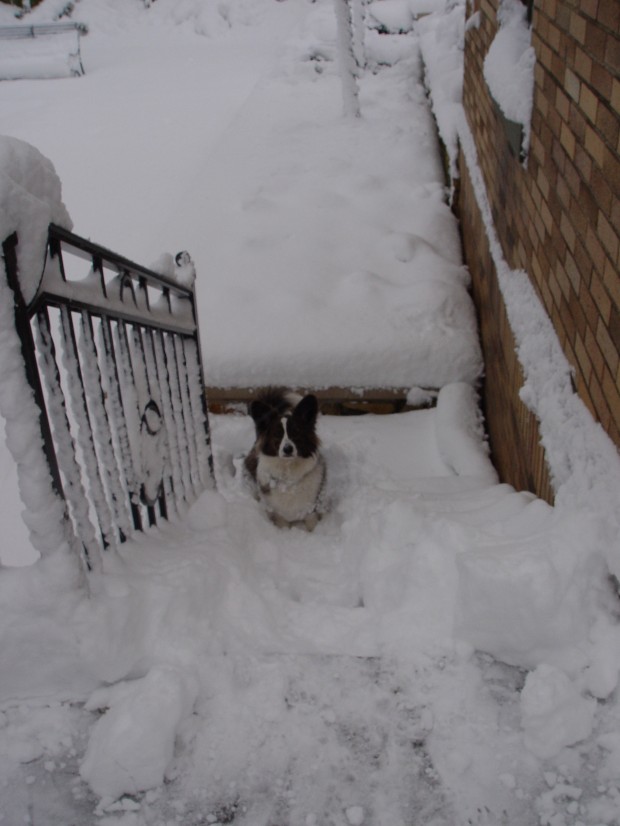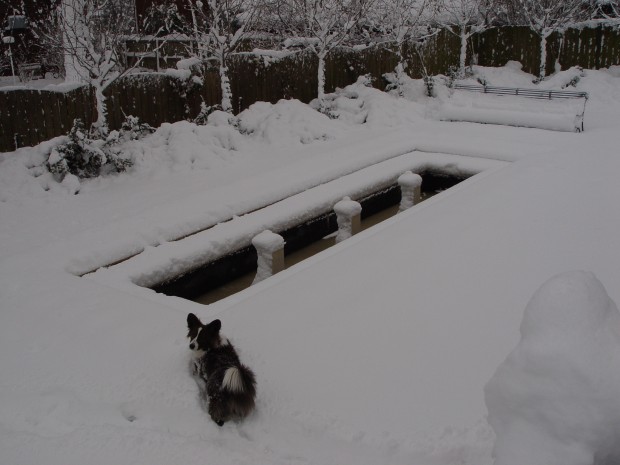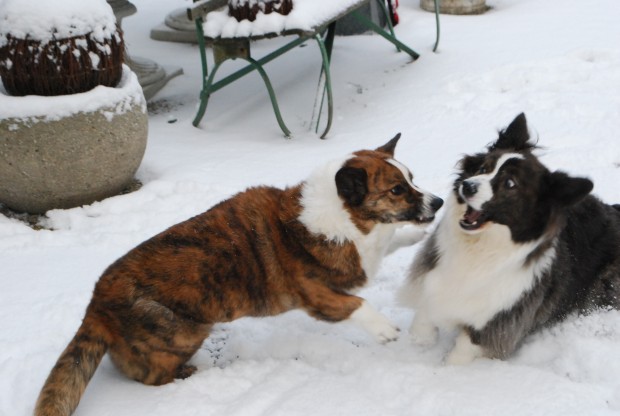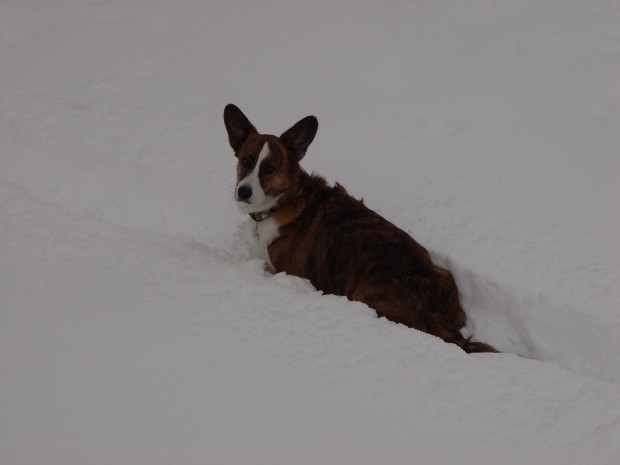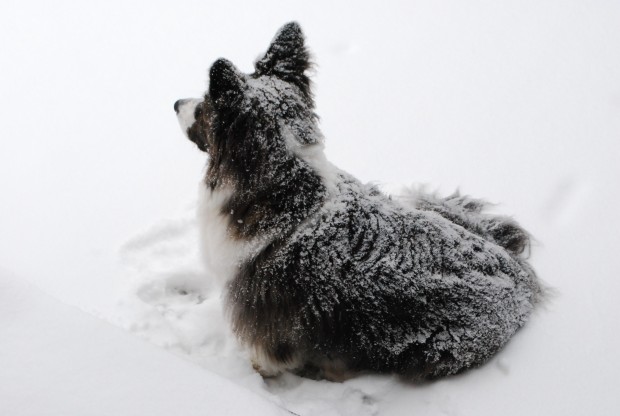 How are the corgis coping with forty some inches of snow? Famously.
How are the corgis coping with forty some inches of snow? Famously.
At A Glance: Snow Down
Say It Ain’t Snow
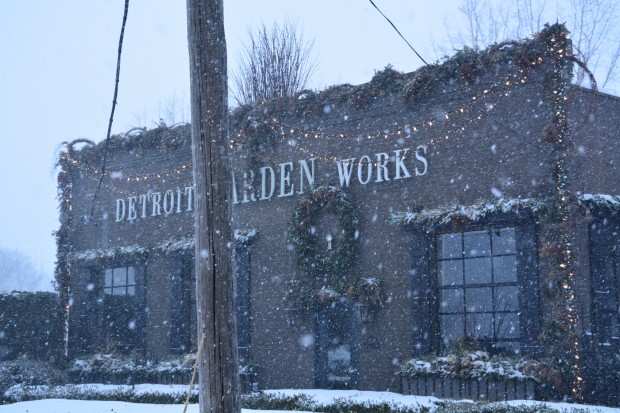 In Detroit, 49.3 inches of snow have fallen so far this winter, more than the full season average of 42.7 inches, and there are at least two months left in winter. Detroit is seeing its snowiest January on record: Detroit has received 31.3 inches so far this month, breaking the old record of 29.6 inches set in January of 1978, according to the weather service’s White Lake Township station. And more snow is on the way. There are those who might think this is a record of dubious merit. But though I am truly tired of the endless snow, I am also much relieved.
In Detroit, 49.3 inches of snow have fallen so far this winter, more than the full season average of 42.7 inches, and there are at least two months left in winter. Detroit is seeing its snowiest January on record: Detroit has received 31.3 inches so far this month, breaking the old record of 29.6 inches set in January of 1978, according to the weather service’s White Lake Township station. And more snow is on the way. There are those who might think this is a record of dubious merit. But though I am truly tired of the endless snow, I am also much relieved.
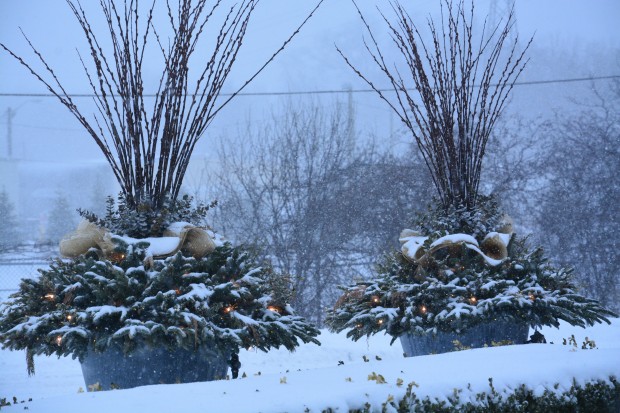 The shop is about 30 miles north of downtown Detroit. The USDA plant hardiness map puts us in Zone 6a. This means that plant which are hardy from -10 degrees below zero to -5 degrees below zero should live and prosper here. True plant hardiness is not all that formulaic. There are invariably mitigating circumstances. Some years those circumstances work for me. Other years, marginally hardy plants slip away. Some zone 7 plants will live for me, provided they are planted in very sheltered spots, and have good drainage. But no matter my efforts, the proof is in the winter putting.
The shop is about 30 miles north of downtown Detroit. The USDA plant hardiness map puts us in Zone 6a. This means that plant which are hardy from -10 degrees below zero to -5 degrees below zero should live and prosper here. True plant hardiness is not all that formulaic. There are invariably mitigating circumstances. Some years those circumstances work for me. Other years, marginally hardy plants slip away. Some zone 7 plants will live for me, provided they are planted in very sheltered spots, and have good drainage. But no matter my efforts, the proof is in the winter putting.
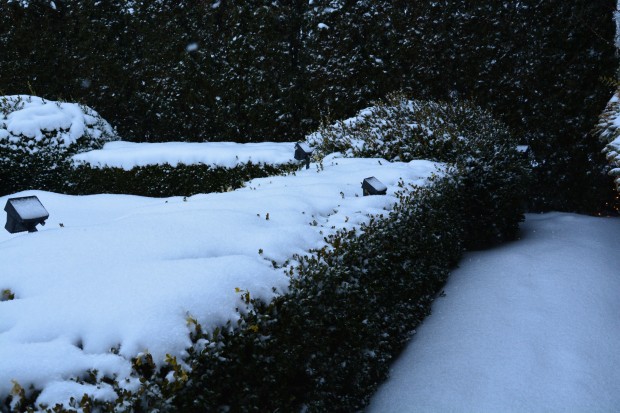 I have clients that have old Franklinia trees, 2 story tall American hollies, Brown Bracken magnolias- and other more southerly specific landscape plants that are healthy and robust, in spite of our plant hardiness zone designation. I am sure that proper siting played a big part in their survival. I have another client who lives in Detroit, and with much effort, mulching and wrapping, overwinters certain palms in the ground. Palms-really? Detroit is a big city with lots of buildings. The mass of all of those buildings holds the heat, and the height of the buildings protects plants from wind. Plants are very specific about what they want, and what they will tolerate. The hardiness borders are not fixed.
I have clients that have old Franklinia trees, 2 story tall American hollies, Brown Bracken magnolias- and other more southerly specific landscape plants that are healthy and robust, in spite of our plant hardiness zone designation. I am sure that proper siting played a big part in their survival. I have another client who lives in Detroit, and with much effort, mulching and wrapping, overwinters certain palms in the ground. Palms-really? Detroit is a big city with lots of buildings. The mass of all of those buildings holds the heat, and the height of the buildings protects plants from wind. Plants are very specific about what they want, and what they will tolerate. The hardiness borders are not fixed.
 There is no reason not to push the envelope, if there is a plant you feel you cannot do without. The -10 degrees to -5 degrees is a worst case scenario in zone 6a. So what gardener doesn’t like to plant dangerously? That is part of the fun of having a garden-stretching the limits. But we have had temperatures that are coming close to that worst case scenario, and colder temperatures yet to come. What does this mean for the garden?
There is no reason not to push the envelope, if there is a plant you feel you cannot do without. The -10 degrees to -5 degrees is a worst case scenario in zone 6a. So what gardener doesn’t like to plant dangerously? That is part of the fun of having a garden-stretching the limits. But we have had temperatures that are coming close to that worst case scenario, and colder temperatures yet to come. What does this mean for the garden?
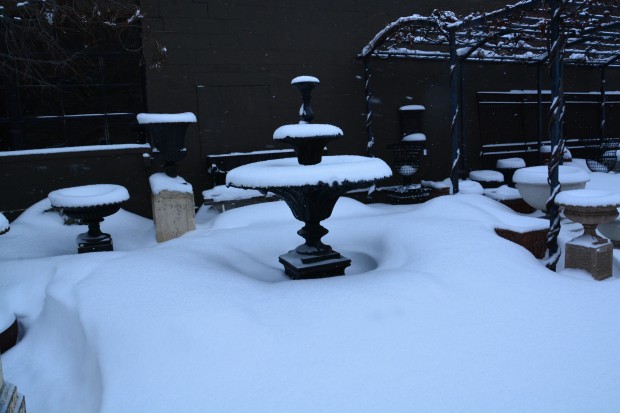 First up, I need to refer back to the snow cover, as amply illustrated above. Snow is water that freezes as it falls. As this granular and crystalline form of water piles up, it forms a blanket which, despite its cold composition, has great insulating properties. Think of all of this frozen water, with air trapped in between each crystal. Years ago I was so surprised to learn that spring flowering bulbs never freeze solid. The earth has a latent heat which keeps most bulbs just at or above freezing. Bulbs that I plant in pots for the winter, that freeze solid through and through for lack of sufficient protection, will rot come spring. Insulation is an important part of weathering the winter.
First up, I need to refer back to the snow cover, as amply illustrated above. Snow is water that freezes as it falls. As this granular and crystalline form of water piles up, it forms a blanket which, despite its cold composition, has great insulating properties. Think of all of this frozen water, with air trapped in between each crystal. Years ago I was so surprised to learn that spring flowering bulbs never freeze solid. The earth has a latent heat which keeps most bulbs just at or above freezing. Bulbs that I plant in pots for the winter, that freeze solid through and through for lack of sufficient protection, will rot come spring. Insulation is an important part of weathering the winter.
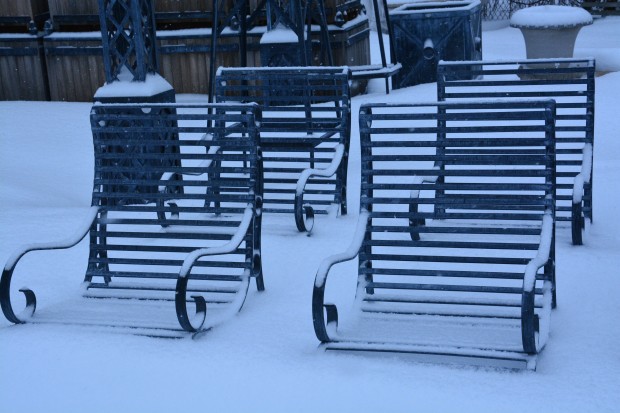 Where am I going with all of this? The insulating role of soil, and in our present case, heavy snow, plays a major role in protecting landscape plants from cold injury. My landscape plants began slowing down in August. In an ideal season, the transition from the growing phase to the sleeping phase is very long, and imperceptibly gradual. Sudden and extreme cold, like what we experienced several springs ago, will catch a plant off guard. A plant which has begun leafing out has had a biological, final, and emphatic call to leaf out. The new shoot that is out there is vulnerable to an abrupt change in conditions. If the environment suddenly goes cold, the new leaves will suffer. If the dramatic cold is cold enough, and long enough, branches of trees can die back. In our cold a few springs ago, many Japanese maples died outright.
Where am I going with all of this? The insulating role of soil, and in our present case, heavy snow, plays a major role in protecting landscape plants from cold injury. My landscape plants began slowing down in August. In an ideal season, the transition from the growing phase to the sleeping phase is very long, and imperceptibly gradual. Sudden and extreme cold, like what we experienced several springs ago, will catch a plant off guard. A plant which has begun leafing out has had a biological, final, and emphatic call to leaf out. The new shoot that is out there is vulnerable to an abrupt change in conditions. If the environment suddenly goes cold, the new leaves will suffer. If the dramatic cold is cold enough, and long enough, branches of trees can die back. In our cold a few springs ago, many Japanese maples died outright.
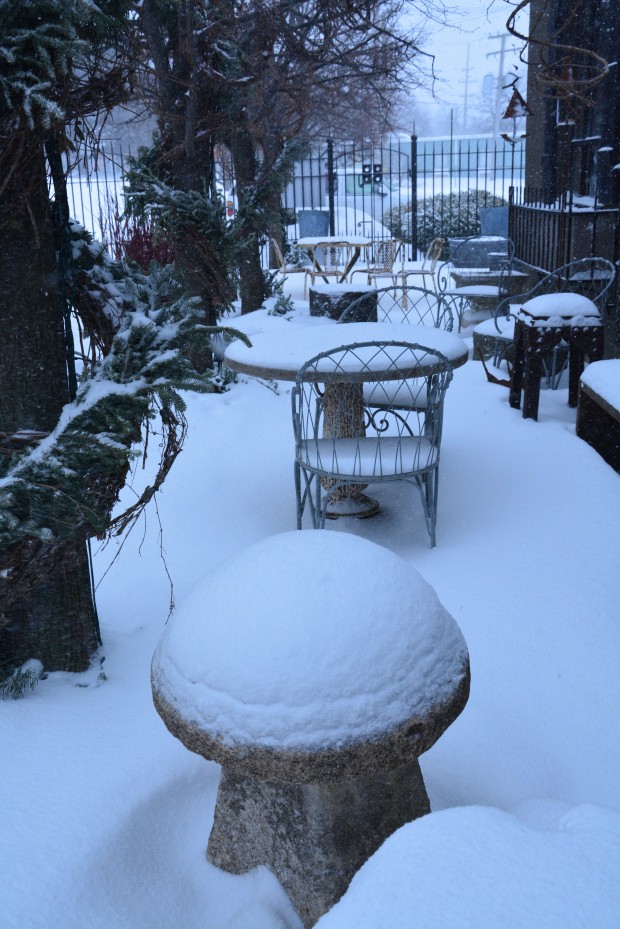 Tulips are well prepared for nature’s mood swings. The leaves poke out of the ground-they test the early spring waters. Unforeseen cold weather can disfigure the leaves, but the buds stay tucked away underground until the weather reliably warms. An unexpected freeze when the tulips are in bud-I shower them with water. The water will freeze before the blooms. Gardeners, and spring blooming plants-they are endowed with incredible fortitude. My trees and shrubs have been dormant a long time. The roots of my magnolias are deep in the soil, and mulched with 40 inches of snow. I am thinking – and hoping – that they will survive this brutal cold without incident.
Tulips are well prepared for nature’s mood swings. The leaves poke out of the ground-they test the early spring waters. Unforeseen cold weather can disfigure the leaves, but the buds stay tucked away underground until the weather reliably warms. An unexpected freeze when the tulips are in bud-I shower them with water. The water will freeze before the blooms. Gardeners, and spring blooming plants-they are endowed with incredible fortitude. My trees and shrubs have been dormant a long time. The roots of my magnolias are deep in the soil, and mulched with 40 inches of snow. I am thinking – and hoping – that they will survive this brutal cold without incident.
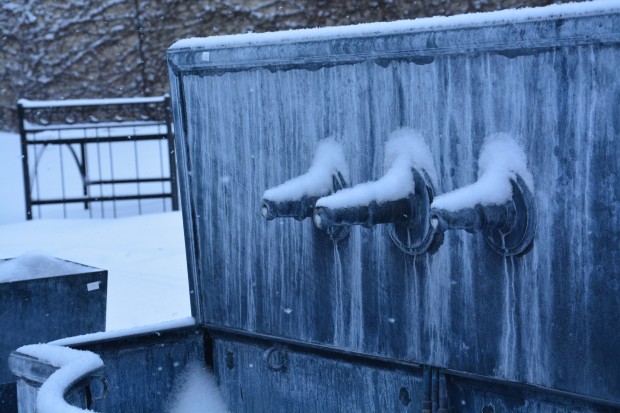 If I have to have the cold, then I want as much snow as possible. Middling cold winters with no snow cover worry me. Though I know the will to live is incredibly strong, will is not everything. Middling cold can damage or kill plants that have no insulation from snow. As utterly bored and irritated as I am by the extreme cold and the relentless snow, I am in the gardening gig for the long run. That would mean a spring in which I see all of my plants leafing out, ready to grow. So bring on that snow.
If I have to have the cold, then I want as much snow as possible. Middling cold winters with no snow cover worry me. Though I know the will to live is incredibly strong, will is not everything. Middling cold can damage or kill plants that have no insulation from snow. As utterly bored and irritated as I am by the extreme cold and the relentless snow, I am in the gardening gig for the long run. That would mean a spring in which I see all of my plants leafing out, ready to grow. So bring on that snow.
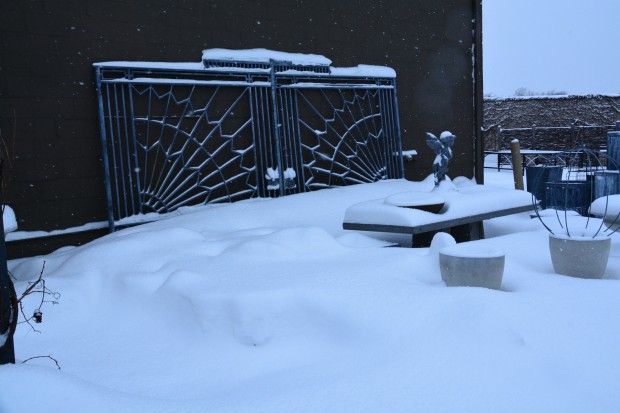 Underneath our 49 inches, a garden.
Underneath our 49 inches, a garden.
Thursday Opinion: A Life Of One’s Own
A few days ago, the feature on my blog which sends emails to subscribers to alert them to a new post went haywire. Subscribers were getting emails every few hours, most of which were for posts I had written years ago. I was appalled. People who subscribed to Dirt Simple were getting spammed. The blog had suddenly gotten a life of its own, and was clogging up innocent inboxes all over the place. I apologize for the nuisance-truly. Debbie Saro, from Web Savvy Marketing, keeps a close watch on all of my wordpress websites. She knew there was a problem long before I got the message from Buck, and wrote to her. She deactivated that portion of the blog immediately, and let WordPress know they had a problem that needed fixing. Astonishingly enough, readers responded favorably to all those emails. I had no complaints. I had lots and lots of readers reading those multiple posts.
It happens all the time. Something in one’s life gets a life of its own, and all one can do is bring up the rear. Our past summer was cold and rainy. I had no say in that decision. Coping with the fallout fell to me. My wishes for stellar summer weather-just wishing. Nature, who most definitely has a life of her own, batted last- as usual. In mid November of this past year, Mother Nature decided to get sudden and serious about winter. By late November, we were chopping frozen soil out of pots in order to do the winter arrangements. We had no warning, nor did we have a grace period. One day all was well. The next day, we had trouble. I was irritated, but I wasn’t waving flags, writing letters, or sounding off on the radio. Why not? Every living thing-and this includes nature-is entitled to a life of their own.
Landscape design is work that I do based on the parameters set by the client, the parameters set by the site, and then there is nature. The drawing that I present to a client is not the beginning and the end. It may look like a document, but it is in fact a description of a big fluid situation. It is an invitation to interact. Plenty of times I have visited a site after I have drawn a design, and gotten back talk. I may call it back talk, but I know better. Any client has a life all their own. Any property has a life all its own. If I am confident, I will let anything pertinent to the design have their moment to speak back. Listening to what gets spoken back will greatly inform your design. My advice? Listen. Have you not had plants that let you know they are not happy where they are planted? Plants have a life of their own. On a good day, I am tuned in to what they see as a life of their own. On a worse day, I am moving plants around.
Just like you, I have a life of my own. I may tag along, or I may insist on forging my own way. I like having freedom of expression. If you are a subscriber who was annoyed about WordPress going rogue, I am sorry. Given how many of you subscribers read multiple old posts over the past few days, I may repost some old essays this winter. Who’s to say WordPress cannot have a life of its own now and then. The now and then is over-for now. Whew!
The Shape of Things to Come
 As Susan Cohan, a very talented and skilled American landscape designer would say, a great landscape design is about making a space work. It works for the client. It works for the plants selected. And it solves problems. No where is that more evident than designing for a very small space. A very small property means every square inch needs to work. This very small front yard needed a decently sized driveway, and a graceful way to get to the front door from both the sidewalk, and the drive. It needed to ground a house that was very tall. It needed to provide a place to watch young children playing on the drive. It needed to provide ongoing visual interest – every bit of which was exposed to the street. It needed to accommodate a client’s interest in a fountain in the front yard.
As Susan Cohan, a very talented and skilled American landscape designer would say, a great landscape design is about making a space work. It works for the client. It works for the plants selected. And it solves problems. No where is that more evident than designing for a very small space. A very small property means every square inch needs to work. This very small front yard needed a decently sized driveway, and a graceful way to get to the front door from both the sidewalk, and the drive. It needed to ground a house that was very tall. It needed to provide a place to watch young children playing on the drive. It needed to provide ongoing visual interest – every bit of which was exposed to the street. It needed to accommodate a client’s interest in a fountain in the front yard. 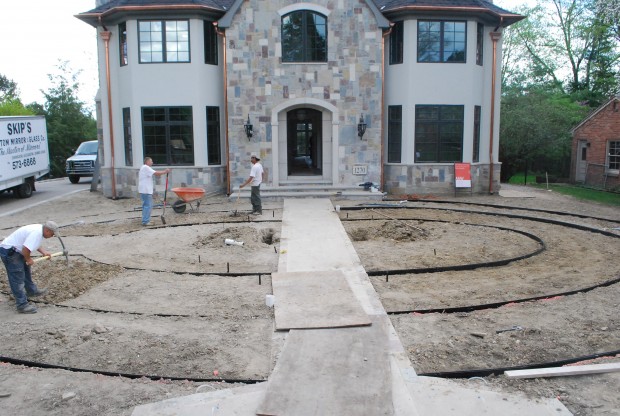 I thought there needed to be a single strong shape which would organize every other element in the landscape. An ellipse seemed a natural choice. The shape of the front yard was a very shallow rectangle. An ellipse would make the most of that natural shape in a more interesting way. An elliptical shape that touched the north side of the driveway, and reached across to the south side would provide a means to reach the front door. It would also permit a way to walk the garden that had no beginning and no end.
I thought there needed to be a single strong shape which would organize every other element in the landscape. An ellipse seemed a natural choice. The shape of the front yard was a very shallow rectangle. An ellipse would make the most of that natural shape in a more interesting way. An elliptical shape that touched the north side of the driveway, and reached across to the south side would provide a means to reach the front door. It would also permit a way to walk the garden that had no beginning and no end.  From the driveway, one ring of the ellipse would be a gravel path that would lead to the front door. That path would also encourage walking through the space. The gravel ellipse was wide enough to accommodate a bench, wherever the client might want one. An interior ellipse of grass would make it possible to view the garden, and the fountains from a number of different vantage points.
From the driveway, one ring of the ellipse would be a gravel path that would lead to the front door. That path would also encourage walking through the space. The gravel ellipse was wide enough to accommodate a bench, wherever the client might want one. An interior ellipse of grass would make it possible to view the garden, and the fountains from a number of different vantage points.  The fountain Buck built was actually a pair of fountains. Each was fabricated as a half-ellipse. Anyone approaching the front door would walk through the fountains. Anyone coming to the front door from the driveway could follow the gravel path, or take the fountain view route. Rows of boxwood and yews matching the curve of the ellipse would give the garden some winter interest. As for the perennial garden, there are but a few plants. The inner ring is a collection of peonies, faced down with alchemilla mollis. Once the peonies mature, they will form a lustrous large leaved interior hedge taller than the boxwood.
The fountain Buck built was actually a pair of fountains. Each was fabricated as a half-ellipse. Anyone approaching the front door would walk through the fountains. Anyone coming to the front door from the driveway could follow the gravel path, or take the fountain view route. Rows of boxwood and yews matching the curve of the ellipse would give the garden some winter interest. As for the perennial garden, there are but a few plants. The inner ring is a collection of peonies, faced down with alchemilla mollis. Once the peonies mature, they will form a lustrous large leaved interior hedge taller than the boxwood. 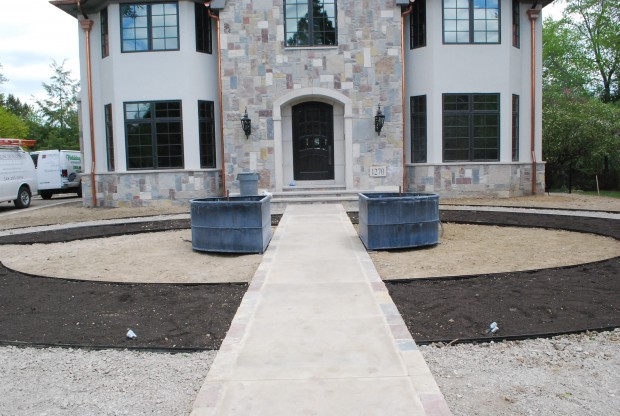 The fountains are the center of interest to the design, and they are front and center. We did eventually move them back off of the sidewalk a bit, just so the space would breathe better. The interior garden would mature at the same height as the fountains. This height was a direct response to the height of the house. I planted yews in the ellipse closest to the house-who would want to block the views from inside out with anything taller? Eventually we would plant a DeGroot Spire arborvitae on either side of the from facade of the house.
The fountains are the center of interest to the design, and they are front and center. We did eventually move them back off of the sidewalk a bit, just so the space would breathe better. The interior garden would mature at the same height as the fountains. This height was a direct response to the height of the house. I planted yews in the ellipse closest to the house-who would want to block the views from inside out with anything taller? Eventually we would plant a DeGroot Spire arborvitae on either side of the from facade of the house.  The lower step to the front door needed to describe that ellipse that governed the shape every other landscape element. Scott Albaugh from Albaugh Masonry did a great job of this. In a very small space, the details matter so much. Our shapes were by no means perfect. But they were accurate enough to be convincing. At this stage in the installation, the ellipses read in a graphically strong way. Once the landscape was planted, that shape became much more subtle.
The lower step to the front door needed to describe that ellipse that governed the shape every other landscape element. Scott Albaugh from Albaugh Masonry did a great job of this. In a very small space, the details matter so much. Our shapes were by no means perfect. But they were accurate enough to be convincing. At this stage in the installation, the ellipses read in a graphically strong way. Once the landscape was planted, that shape became much more subtle. 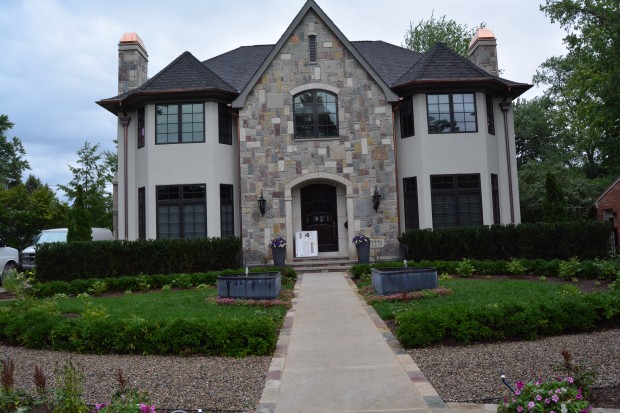 The day a landscape is installed is just that-the first day. Given some time for the plants to mature, that ellipse describing the horizontal ground plane will be softened by the height and the sprawl of the plants.
The day a landscape is installed is just that-the first day. Given some time for the plants to mature, that ellipse describing the horizontal ground plane will be softened by the height and the sprawl of the plants.  This design looks different from different vantage points. Changing the visual channel is easy; there is a path.
This design looks different from different vantage points. Changing the visual channel is easy; there is a path. 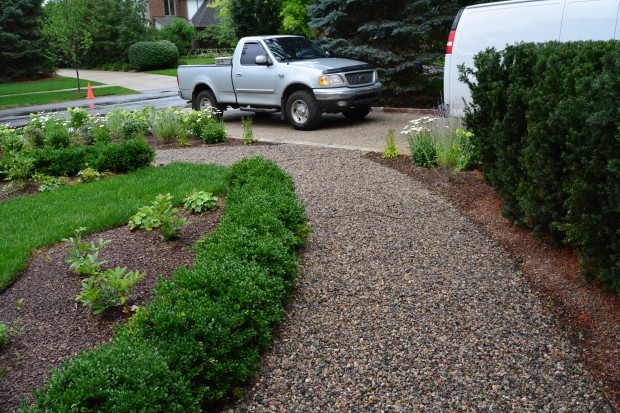 Any guest getting out of the car in the driveway could find their way to the front door. They might take the long way-or the short way, in bad weather. This design is intended to make the garden accessible and friendly to people. Though just about every idea can be seen from the drive or the street, the elliptical path invites a stroll through.
Any guest getting out of the car in the driveway could find their way to the front door. They might take the long way-or the short way, in bad weather. This design is intended to make the garden accessible and friendly to people. Though just about every idea can be seen from the drive or the street, the elliptical path invites a stroll through.  What can readily be seen now will not always be the case. The outer ring of this garden will mature at a height of 4 to 5 feet. Roses, shasta daisies, Russian sage, Little Lime hydrangeas-the height of these plants will provide a little mystery and privacy to the inner ellipse. The border on the sidewalk-moss phlox and lamb’s ear.
What can readily be seen now will not always be the case. The outer ring of this garden will mature at a height of 4 to 5 feet. Roses, shasta daisies, Russian sage, Little Lime hydrangeas-the height of these plants will provide a little mystery and privacy to the inner ellipse. The border on the sidewalk-moss phlox and lamb’s ear.  I will be very interested to see this garden when it has a few more years on it. Hopefully it will be a small space that has something interesting going on.
I will be very interested to see this garden when it has a few more years on it. Hopefully it will be a small space that has something interesting going on.

